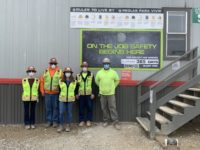A new coalition of four firms is making a joint open call for technology solutions that could advance new, and changing, COVID-19 safety standards – with the promise that workable findings and best practices will be shared with the industry at large.
The NEXT Coalition, formed by Black & Veatch, DPR Construction, Haskell and McCarthy Building Cos., launched the Construction Safety Challenge, a call for close-to-market technology that addresses evolving COVID-19 safety standards and can be quickly developed, scaled and deployed.
Mike Myers, president of McCarthy’s Southern California region, says the coalition was formed three weeks ago when Black & Veatch, which launched its similar concept-call IgniteX COVID-19 Response Accelerator in March, reached out. Myers calls the partnership a “no brainer” because its mission—to drive ideas and innovation—aligns with McCarthy’s belief that safety happens through collaboration.
“It’s open source, so we are trying to reach anyone and everyone as quickly as we can, because the challenge is right now,” says Myers. Once ideas are submitted, they are divvied to one firm that will test and evaluate the technology and report back to the coalition with its feasibility findings. Each firm will fund its own tests. The coalition is not a profit center; funding of full development and implementation of ideas has not yet been determined.
Brett Spence, a member of Black & Veatch’s innovation strategy team Growth Accelerator, is excited about the possibilities around contact tracing and notes that concepts by tech giants like Apple Inc. and Google Inc. could be useful, but not necessarily applicable if groups don’t use compatible technology. While too soon to tell, Spence also sees promise in ideas around ozone cleaning and temperature checks installed in restrooms. For any concept, time is of the essence.
“We don’t have time to incubate something for a year,” Spence says. The coalition will accept new partners and expects to share workable findings with the industry at large. “When it comes to keeping people safe, we all shouldn’t worry about things like competition. We should really be driving solutions together, and it’s neat to see it actually happening, especially in this crazy world we live in and it happening so quickly.”
The coalition is looking for technology that could include screening, mobile apps, disinfection, wearables, contact tracing and PPE, that applies to safety policy compliance, screening, tracking and tracing, real-time communication, incident tracking and data analytics. Hamzah Shanbari, manager of construction technology at Haskell, expects entries to come from construction industry startups, which are pivoting and adapting concepts and tools to address COVID-19 needs, that need help with product scale.
McCarthy’s Myers points to a need for advancing PPE, especially as summer approaches. Where face coverings are required, workers face complications like fogging eye protection and possible heat exhaustion that could spurred by PPE meant to protect them. Sanitation and social distancing technology development is also need, and Myers says changes due to automation and other innovations could have long-term industry impact.
Michelle Gray, DPR Construction safety leader in Sacramento, Calif., notes that current COVID-19 protocols are reactive, not proactive, and were implemented to immediately protect people, keep projects online and the workforce working. Now, Gray says the industry has the chance to devise ways to protect workers and ensure preparedness for disruptions.
“The beauty of open-source safety is people might see simple things from a different perspective and create a great tool or technology to meet a known or unknown need,” says Gray.




